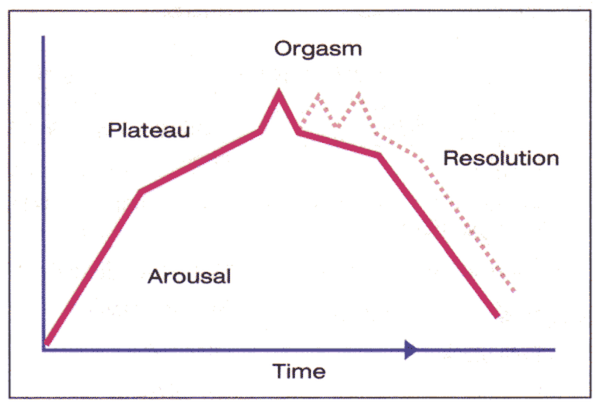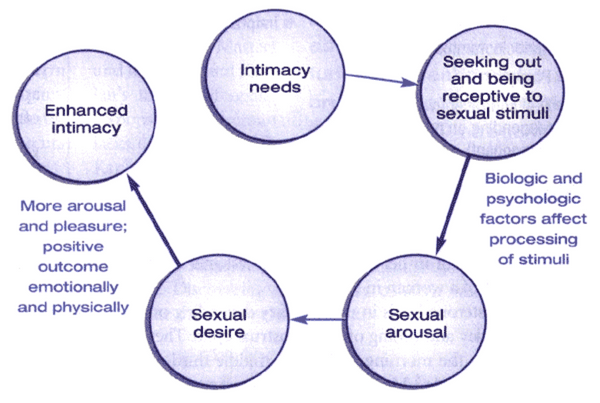What You Need to Know About the Sexual Response Cycle

I'm excited to talk about the three theories of the sexual response cycle and orgasms. If you have not heard the phrase ‘sexual response cycle’ before, it refers to the sequence of both physical and emotional changes that occur as we become sexually aroused and then continue to participate in sexual activities.
So knowing how your body responds during each phase of this response cycle can absolutely enhance your sexual relationship with yourself and with other people.
The three response cycles that we're going to go over are:
1) Masters & Johnson
2) Kaplan
3) Bassan
Masters & Johnson: Sexual Response Cycle
Masters & Johnson’s sexual response cycle starts with arousal and it continues with arousal, arousal, arousal until you're getting aroused. Then you start to hit what's called the plateau. Then, orgasm and resolution. Sound familiar?

The excitement and arousal phase, the first step in this arousal cycle, can last minutes or hours. Some of the things that occur during this phase are muscles get a little tense, a vagina may get wet, your skin may get flushed, your heart rate and breathing accelerating, your nipples may become hard, and the breasts are becoming fuller.
A penis will become erect, and the vaginal walls will swell. The testes swell, the scrotum tightens, and often the penis will secrete a lubricating liquid.
Sexual Response Plateau Phase:
Then, we get into the plateau phase. The plateau is the excitement intensifying right up to orgasm. You’ll feel the increased muscle tension, breathing, heart rate, and blood pressure, and the vagina swells from blood flow. And here's a fun fact – the walls of the vagina turn dark purple during this stage. You can even learn how to squirt when you near the plateau phase.
Then, the clitoris becomes incredibly sensitive and often tries to hide under the clitoral hood to avoid direct stimulation. Sometimes, muscle spasms in your face, feet, and hands will h, bringing you to orgasm. The climax of the sexual response cycle is the shortest phase of all of them.
Some indicators of orgasm include involuntary muscle contractions, a rash or a “sex flush” might show up, muscles in your feet may spasm, and you might feel a sudden or forceful release of sexual tension. Then your blood pressure and heart rate in everything is at their highest rate at this point.
The uterus and vagina actually undergo contractions, which is why orgasms are so good for relieving period cramps. And for those with a penis, the base of the penis undergoes those same rhythmic contractions, which results in the semen being released from the testes.
Make sense? We all have the same parts, just organized differently.
Kaplan: Sexual Response Cycle
Now, Kaplan's sexual response model looks a little bit different. Kaplan's model says the whole thing just kind of builds up and builds up and builds up and then just falls off.

Kaplan calls it desire, excitement, and orgasm. That's it. That's their model.
Bassan: Sexual Response Cycle
And then Bassan came up with a female-specific model, which I'm a little mixed about. Their model is there is a need for intimacy, then we seek it out and are more receptive to something sexual and intimate.

Then we experience sexual arousal, and then we experience sexual desire, and then we have enhanced intimacy. This model is different because this is actually the emotional cycle, not the physical one.
I’d love to take this opportunity to talk more about orgasms since they are a part of almost every sexual response cycle.
Did you know that there are 12 different ways that vulva owners can orgasm?
- Clitoral
- Vaginal or G spot
- Blended orgasm (meaning more than one type at once)
- Multiple orgasms
- Anal orgasms
- Sleep orgasms, aka Snoregasm
- Cervical Orgasm
- U-Spot Orgasm (Squirting)
- A-Spot Orgasm
- Nipple Orgasm
- Coregasm
- Expanded Sexual Response
These are the 12 types of orgasms. Now if you're thinking, “wow, I've had a couple of those,” or maybe even one – ask yourself, what do you want? What do you wanna experience? What do you wanna feel?
Did you know prostate owners, can six different types of orgasms?
- Ejaculatory orgasm
- Blended orgasm (or a whole body),
- Wet dream
- Multiple orgasms
- Pelvic orgasm (which happens when you edge, which means brain bringing yourself almost to the brink of orgasm, stopping and backing off, and then coming to the verge of orgasm. And then backing off.
- Prostate orgasm (the male G spot, aka the P spot)
The thing is, though, it is not always about the orgasm. Try to focus on the experience, whether alone or with someone else or ten other people, and instead of attaching to this outcome that you're trying to get to, pay attention and focus on the experience.
The experience is pleasure. In all the sexual response cycles, the orgasm is the shortest part. It's the shortest part. And yet we put so much focus on it.
Sometimes, all the focus. And the reality is, is that there may be many reasons why someone may have trouble orgasming. And most of the time, it does not have to do with their partner's lack of skill.
Just because someone did an orgasm doesn't mean they did not experience pleasure. If we're looking at sex as a meaningful experience of pleasure, does that say anything about orgasming? No. I bet you can think of many times when you had an incredible sexual experience that did not involve an orgasm.
Resolution
Finally, the last stage in the Masters & Johnson cycle is resolution. The body, after orgasm, slowly returns to its average level of functioning. And our body parts return to their prior size and prior color. Often we have this overwhelming sense of happiness or well-being and maybe a little fatigue. Then, the oxytocin starts pumping, so we feel close to whoever we're with.
And then there’s the refractory period, which is just a fancy name for the time it takes between orgasms for someone – which varies a lot from person to person. It varies based on gender, age, and medicines – many factors.
For some people, they can get orgasm, orgasm, orgasm, orgasm, orgasm. And then, for others, it's like one and done. Everybody's refractory period is different. It's terrific to get to know what yours is so that if it changes, you know something is different. And the difference doesn't mean anything; it's just good to know it's different.
Go forth and enjoy the entirety of the sexual response cycles!
Try Zumio
Zumio Sadie
Zumio Ethel
Zumio Xena
Zumio Iyana
Own Your Orgasm
Zumio’s clitoral stimulator has patented SpiroTip™ rotation technology that lets you pinpoint your exact pleasure spots for the most satisfying orgasm imaginable.
Experience it for yourself!





